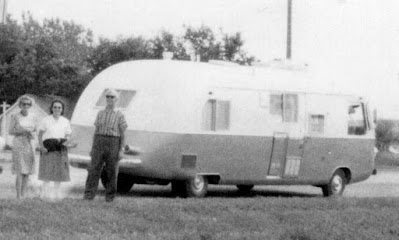Previous coaches had a diagonal side frame that followed the windshield shape and established the rear edge of the front corner panel. With #202 Peterson shortened the forward body, truncated the diagonal frame, and developed a new fiberglass corner panel that wrapped back to the vertical frame at the front of the wheel well. This resulted in the first 22 foot long coach, with its distinctive narrow slider window shape.
#202 was also the first to use ethafoam bumpers cemented directly to the body, with the now-standard Bargman "wedding cake" taillights installed above the rear bumper and small backup lights installed below. Like #201, the taillights were mounted lower than what would eventually become standard with coaches after #206. This was the last coach with the front turn signals mounted inside the Ford Econoline headlight bezels.
Removable holding tanks were installed beneath the floor, made of riveted aluminum and lined with sealant to prevent leaks. The 1964 "camber compensator" rear suspension was used, with the new 110 hp engine and 13" ornamental dually wheels. Weighing in at 2,875 lbs (with 5 gallons of gas), #202 was also an exceptionally light weight coach and acceleration with the stroked-out engine was brisk.
A unique new configuration was developed at the Lanes' request, with the galley installed directly behind the passenger seat and the entry door moved rearward. A slightly taller refrigerator was used, with the usual drawer above it reduced to a sliding counter extension.
The galley was arranged with the stove on the left (next to the passenger seat) and the refrigerator on the right (next to the entry door). Note that the stove had also been installed to the left in #101, #200, #103, #63104, and #201, but was on the right in #104, #163102 and #264105.
The usual molded fiberglass canopy above the front seats was omitted, but upper cabinets were built into both sides of the cockpit. The front wheel well on the driver side received an extension to support the bench seat, but the passenger side did not. A wall furnace was installed on the front bathroom wall next to the entry door.
William and Grace became charter members of the UVMCC in 1967, having moved to Baldwin Park. They registered their coach with the Club as #13, moved to Pacoima in 1970, and let their membership expire after 1971. The sealant lining the inside of the fuel tank started crumbling and clogging the carburetors, and William wasn't able to resolve the issue.
The usual molded fiberglass canopy above the front seats was omitted, but upper cabinets were built into both sides of the cockpit. The front wheel well on the driver side received an extension to support the bench seat, but the passenger side did not. A wall furnace was installed on the front bathroom wall next to the entry door.
William and Grace became charter members of the UVMCC in 1967, having moved to Baldwin Park. They registered their coach with the Club as #13, moved to Pacoima in 1970, and let their membership expire after 1971. The sealant lining the inside of the fuel tank started crumbling and clogging the carburetors, and William wasn't able to resolve the issue.
He parked the coach with about 37,500 miles on the odometer, then in February 1987 Jim Craig bypassed the fuel tank with a 5 gallon gas can and drove it home to San Diego with no further problems. Jim and Marlene put another 12,500 miles on the coach in under 2 years, and after moving to Joshua Tree in 1988 they offered the coach for sale at $6,995, later reduced to $5,495.
Donald Gilbert of Midland TX bought the coach in December 1988, offering it for sale again at $5,250 in 1990, although by mid-1991 the asking price had been reduced to $3,500. Richard K. Morrison of La Luz NM owned the coach next, and although he let his Club membership expire in 1996, the coach remained in his family until Ken Morrison of Fort Collins CO sold it in 2011.
Donald Gilbert of Midland TX bought the coach in December 1988, offering it for sale again at $5,250 in 1990, although by mid-1991 the asking price had been reduced to $3,500. Richard K. Morrison of La Luz NM owned the coach next, and although he let his Club membership expire in 1996, the coach remained in his family until Ken Morrison of Fort Collins CO sold it in 2011.
By this time the driver side seat pedestal extension appears to have been removed, the unique dual bullet-style front turn signals replaced, and a steel tube front bumper and towbar arrangement installed. The coach was damaged during the delivery to the San Antonio TX buyer, and its current condition, location, and owner is unknown.


















